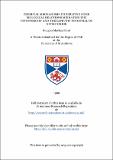Files in this item
Chemical mechanisms underlying some biological reactions mediating the cytotoxicity and therapeutic potential of nitric oxide
Item metadata
| dc.contributor.advisor | Butler, Tony | |
| dc.contributor.author | Short, Douglas Mackay | |
| dc.coverage.spatial | 191 p. | en_US |
| dc.date.accessioned | 2018-06-15T09:53:05Z | |
| dc.date.available | 2018-06-15T09:53:05Z | |
| dc.date.issued | 1999 | |
| dc.identifier.uri | https://hdl.handle.net/10023/14102 | |
| dc.description.abstract | Some in vitro reactions of peroxynitrite are examined using 15N CIDNP NMR spectroscopy to elucidate more information about the radical nature of nitration, nitrosation and isomerisation mechanisms. Preliminary work on the nitration of tyrosine with H15NO3 confirms that 3-nitrotyrosine forms predominantly by the same radical mechanism established for other activated aromatic compounds such as 4-methylphenol. Reaction of alkaline [15N] peroxynitrite with biotarget-type molecules such as tyrosine, a tyrosine-containing tripeptide and thiol-containing amino acids allows nuclear polarisation effects to be discerned which are consistent with free and solvent-caged NO2 and HOo or CO3. The phase of the nitrate signal observed during peroxynitrite isomerisation at pH 7.4 is opposite to that observed during reaction with a biotarget-type molecule, suggesting dimerisation of NO2 to N2O4 and its subsequent hydrolysis in addition to in cage geminate pair collapse. Mechanisms in accord with the observations are suggested and their implications and extent to which they concur with established theories are discussed. Kinetic simulations are used to estimate the relative importance of nitryl chloride and peroxynitrite as in vivo reactive nitrogen species. Three furazan 2-oxide (furoxan) derivatives with potent NO- donating activity were synthesised according to literature methods and their decomposition in aqueous solution to yield NO was examined using EFR spectroscopy by spin trapping with Fe2+-N-methyl-D-glucamine dithiocarbamate (Fe2+-MGD). Ammonia, arising from thiol-mediated reductive decomposition pathways, was also detected in quantities up to approximately 8% of the nitrogen- containing decomposition products. A commercially-available enzymatic assay based on reductive amination of 2-oxoglutai-ate using L-glutamate dehydrogenase and NADPH was used. The proportion of furoxan giving rise to these products is estimated and possible mechanisms for their generation are suggested. | en_US |
| dc.language.iso | en | en_US |
| dc.publisher | University of St Andrews | |
| dc.subject.lcc | QP921.N5S7 | |
| dc.subject.lcsh | Nitric oxide | en |
| dc.title | Chemical mechanisms underlying some biological reactions mediating the cytotoxicity and therapeutic potential of nitric oxide | en_US |
| dc.type | Thesis | en_US |
| dc.contributor.sponsor | Biotechnology and Biological Sciences Research Council (BBSRC) | en_US |
| dc.type.qualificationlevel | Doctoral | en_US |
| dc.type.qualificationname | PhD Doctor of Philosophy | en_US |
| dc.publisher.institution | The University of St Andrews | en_US |
This item appears in the following Collection(s)
Items in the St Andrews Research Repository are protected by copyright, with all rights reserved, unless otherwise indicated.

